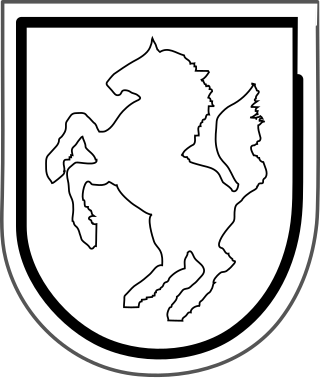
The 334th Infantry Division was a German Army infantry division in World War II. Originally formed in November 1942, it surrendered to the Allies at the conclusion of the Tunisian Campaign in May 1943. The division was reconstituted on 3 June 1943 in France within the 1st Army, with the staff of the 80th Infantry Division as well as remnants of the old division and replacement units. It spent the remainder of the war serving on the Italian Front.
The German XXXVIII Corps was a German army corps during World War II.

The 32nd Infantry Division of the German Army was mobilized on 1 August 1939 for the upcoming invasion of Poland. At that time, it consisted of the usual German infantry division elements: three infantry regiments of three battalions each, one three-battalion regiment of light artillery, one battalion of heavy artillery, a Panzerjäger (anti-tank) Battalion, a reconnaissance (Aufklärungs) Battalion, a Signals Battalion, a Pioneer (Engineer) Battalion, and divisional supply, medical, and administrative units.

The VI Corps was an infantry corps of the German Army. It fought in several notable actions during World War II.

The 30th Infantry Division of the Wehrmacht was created on 1 October 1936 in Lübeck and mobilized on 26 August 1939 for the upcoming invasion of Poland. At that time, it consisted of the usual German infantry division elements: three infantry regiments of three battalions each, one three-battalion regiment of light artillery, one battalion of heavy artillery, a panzerjager (anti-tank) battalion, an aufklärungs (reconnaissance) battalion, a signals battalion, a pioneer (engineer) battalion, and divisional supply, medical, and administrative units.

The 15th Infantry Division was an infantry division of the German Army during the interwar period and World War II, active from 1934 to 1945.

The 93rd Infantry Division was a German infantry division that was formed in the fall of 1939. The division fought in the Second World War in both the Battle of France and on the Eastern Front. It was ultimately destroyed by the Red Army in March 1945 while defending East Prussia.
II Army Corps was a corps in the German Army during World War II.

V Army Corps was a corps in the German Army during World War II.

German XI. Corps was a corps in the German Army during World War II.
VII Army Corps was a corps in the German Army during World War II. It was destroyed in August 1944 during the Jassy–Kishinev Offensive.

VIII Army Corps was a corps in the German Army during World War II. It was destroyed during the Battle of Stalingrad and reformed in mid-1943.
IX Army Corps was a corps in the German Army during World War II. It was formed on 1 October 1934 under the command of General Friedrich Dollman in Kassel with the camouflage name of Kassel and redesignated IX Corps after the creation of the Wehrkreis IX recruitment and training area.
German XIII. Corps was a corps in the German Army during World War II. It was destroyed during the Lvov–Sandomierz Offensive and reformed in late 1944.
XII Army Corps was a corps in the German Army during World War II. It was formed in the Wehrkreis XII recruitment and training district in Wiesbaden in October 1936 and was mobilized before the outbreak of war at the end of August 1939.
XIII Army Corps was a corps of the German Army during World War II. Made up of several divisions, which varied from time to time, it was formed in Nuremberg on 1 October 1937.
The XXIV Army Corps was a unit of the German Army during World War II. The unit was re-designated several times; originally being Generalkommando der Grenztruppen Saarpfalz, later Generalkommando XXIV. Armeekorps, then XXIV. Armeekorps (mot.) and finally XXIV. Panzerkorps.
German XXXV. Corps was a corps in the German Army during World War II.

XXXXIII Army Corps was a corps in the German Army during World War II.
German XXXIII. Corps was a corps in the German Army during World War II.









